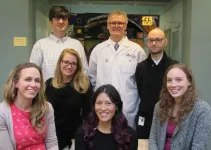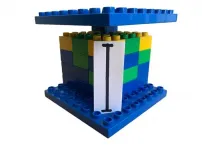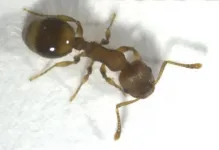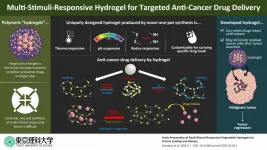Research brief: Reflecting sunlight could cool the Earth's ecosystem
2021-04-07
(Press-News.org) Published in the Proceedings of National Academy of Sciences, researchers in the Climate Intervention Biology Working Group -- including Jessica Hellmann from the University of Minnesota Institute on the Environment -- explored the effect of solar climate interventions on ecology.
Composed of climate scientists and ecologists from leading research universities internationally, the team found that more research is needed to understand the ecological impacts of solar radiation modification (SRM) technologies that reflect small amounts of sunlight back into space. The team focused on a specific proposed SRM strategy -- referred to as stratospheric aerosol intervention (SAI)) -- to create a sulfate aerosol cloud in the stratosphere to reduce a portion of incoming sunlight and radiation. In theory, this cloud could be controlled in size and location.
SAI is like placing tiny reflective particles in the atmosphere to bounce a portion of the solar radiation back to space, so that some of the radiation does not reach -- and warm -- Earth.
The team emphasizes that greenhouse gas emissions reduction and conservation of biodiversity and ecosystem functions must be the priority.
"We are just starting to consider the risks and benefits of geoengineering, and it's critical that we include ecosystems in cost-benefit studies", said Hellmann, director at the U of M Institute on the Environment. "We should only pursue geoengineering if its benefits strongly outweigh its downsides. Because our efforts to stem climate change are modest and slow, the case for considering geoengineering is growing, and this paper represents the ecologists chiming in to the geoengineering conversation."
The complexity of cascading relationships between ecosystems and climate under SAI -- in combination with the timing, amount, length and termination of SAI scenarios -- means that SAI is not a simple thermostat that turns down the heat a couple of degrees. Other potential effects of SAI include shifts in rainfall and increases in surface UV rays. While SAI might cool an overheated Earth, it would not be able to counter all of the effects of rising atmospheric CO2, such as halting ocean acidification.
"When we approach complex questions like these, there is a broad scale, theoretical understanding of the inherent patterns of biodiversity across the surface of Earth, but this understanding is often informed by finer-scale experiments that test the biological and physical mechanisms underlying those patterns," said Phoebe Zarnetske, study co-lead and an associate professor in Michigan State University's Department of Integrative Biology and the Ecology, Evolution, and Behavior program.
"I hope the paper can convince ecologists that research about nature's responses to solar geoengineering is not just important, but also interesting -- touching on core ecological questions about topics as varied as photosynthesis and animal migration," said U of M alum Shan Kothari, who contributed to the study during his time at the College of Biological Sciences before going to the University of Montreal.
Kothari said that an example of how other scientists can consider the study's findings is to contemplate the unique conditions resulting from solar geoengineering scenarios that may aid or impede the ability for ecosystems to store carbon. He added that such research could help the international community consider solar geoengineering with a stronger awareness of the potential risks and benefits involved.
INFORMATION:
The study's co-lead is Jessica Gurevitch, an ecologist at Stony Brook University in New York. This research was funded by the National Science Foundation.
ELSE PRESS RELEASES FROM THIS DATE:
2021-04-07
BIRMINGHAM, Ala. - Race associates with the risk of death from end-stage heart failure. So, identifying the molecular determinants of that risk may help the pursuit of the novel diagnosis and prognosis of heart failure, and its therapy.
A University of Alabama at Birmingham study of end-stage heart-failure patients has found that cytosine-p-guanine, or CpG, methylation of the DNA in the heart has a bimodal distribution among the patients, and that race -- African American versus Caucasian -- was the sole variable in patient records that explained the difference. A subsequent ...
2021-04-07
More than 20 years after the discovery of the parkin gene linked to young-onset Parkinson's disease, researchers at The Ottawa Hospital and the University of Ottawa may have finally figured out how this mysterious gene protects the brain.
Using human and mouse brain samples and engineered cells, they found that the parkin protein works in two ways. First, it acts like a powerful antioxidant that disarms potentially harmful oxidants in the brain, including dopamine radicals. Second, as the brain ages and dopamine radicals continue to build up, parkin sequesters these harmful molecules in a special storage site within vulnerable nerve cells, so they can continue to ...
2021-04-07
CHARLOTTESVILLE, Va. -- If, as the saying goes, less is more, why do we humans overdo so much?
In a new paper featured on the cover of Nature, University of Virginia researchers explain why people rarely look at a situation, object or idea that needs improving -- in all kinds of contexts -- and think to remove something as a solution. Instead, we almost always add some element, whether it helps or not.
The team's findings suggest a fundamental reason that people struggle with overwhelming schedules, that institutions bog down in proliferating red tape, and, of particular ...
2021-04-07
Mobility tracking using cell phone data showing greater movement of people is a strong predictor of increased rates of COVID-19, according to new data in CMAJ (Canadian Medical Association Journal).
"This study shows that mobility strongly predicts [severe acute respiratory syndrome coronavirus 2] SARS-CoV-2 growth rate up to 3 weeks in the future, and that stringent measures will continue to be necessary through spring 2021 in Canada," writes Dr. Kevin Brown, Public Health Ontario, with coauthors.
Until Canadians are widely vaccinated against SARS-CoV-2, nonpharmaceutical public health interventions such as physical distancing and limiting social contact will be the main population-based means of controlling the spread of the virus.
"Mobility ...
2021-04-07
While studying genetic diversity in bumblebees in the Rocky Mountains, USA, researchers from Uppsala University discovered a new species. They named it Bombus incognitus and present their findings in the journal Molecular Biology and Evolution.
Bumblebees are vital for agriculture and the natural world due to their role in plant pollination. There are more than 250 species of bumblebee, and they are found mainly in northern temperate regions of the planet. Alarmingly, many species are declining due to the effects of climate change, and those with alpine and arctic habitats are particularly threatened. However, the full diversity of bumblebee ...
2021-04-07
The hormone auxin is of central importance for the development of plants. Scientists at the University of Bayreuth and the Max Planck Institute for Developmental Biology in Tübingen have now developed a novel sensor that makes the spatial distribution of auxin in the cells of living plants visible in real time. The sensor opens up completely new insights into the inner workings of plants for researchers. Moreover, the influences of changing environmental conditions on growth can now also be quickly detected. The team presents its research results in the journal Nature.
The effects of the plant hormone auxin were first described ...
2021-04-07
Ants react to social isolation in a similar way as do humans and other social mammals. A study by an Israeli-German research team has revealed alterations to the social and hygienic behavior of ants that had been isolated from their group. The research team was particularly surprised by the fact that immune and stress genes were downregulated in the brains of the isolated ants. "This makes the immune system less efficient, a phenomenon that is also apparent in socially isolating humans - notably at present during the COVID-19 crisis," said Professor Susanne Foitzik, who headed up the study at Johannes ...
2021-04-07
Cancer therapy in recent times relies on the use of several drugs derived from biological sources including different bacteria and viruses, among others. However, these bio-based drugs get easily degraded and therefore inactivated on administration into the body. Thus, effective delivery to and release of these drugs at target tumor sites are of paramount importance from the perspective of cancer therapy.
Recently, scientists have discovered unique three-dimensional, water-containing polymers, called hydrogels, as effective drug delivery systems (DDSs). Drugs loaded into these hydrogels remain relatively stable owing to the network-like structure and organic tissue-like consistency of these DDSs. Besides, drug release from hydrogels can ...
2021-04-07
By Karina Ninni | Agência FAPESP – A multidisciplinary research group affiliated with the Department of Physical Education’s Human Movement Laboratory (Movi-Lab) at São Paulo State University (UNESP) in Bauru, Brazil, measured step length synergy while crossing obstacles in patients with Parkinson’s disease and concluded that it was 53% lower than in healthy subjects of the same age and weight. Step length is one of the main variables affected by the disease.
Synergy, defined as combined operation, refers in this case to the capacity of the locomotor (or musculoskeletal) system to adapt movement while crossing an obstacle, combining factors such as speed and foot position, for example. Improving synergy in Parkinson’s patients while they ...
2021-04-07
You might not think an animal made out of stone would have much to worry about in the way of predators, and that's largely what scientists had thought about coral. Although corallivores like parrotfish and pufferfish are well known to biologists, their impact on coral growth and survival was believed to be small compared to factors like heatwaves, ocean acidification and competition from algae.
But researchers at UC Santa Barbara have found that young corals are quite vulnerable to these predators, regardless of whether a colony finds itself alone on the reef or surrounded by others of its kind. The research, led by doctoral student Kai Kopecky, appears in the journal Coral Reefs.
Kopecky and his co-authors ...
LAST 30 PRESS RELEASES:
[Press-News.org] Research brief: Reflecting sunlight could cool the Earth's ecosystem








